Trostyanets History
By
Related to: Trostyanets (Town),
Provided by Wayne Frankel
by Victoria Khiterer, Ph.D.
In
Jewish places in the Ukraine, A historical guide, Volume 2
Trostianets, Podolia
pp. 266-282
Seven illustrations (overleaf plus Ill. 160-167)
Illustrations courtesy of Benjamin Lukin, Alla Sokolova and Boris Khaimovich.
Publisher: Alexander Gherst, St. Petersburg, 2000
(Translation by Petko Petkov, Bar Harbor, 2010)
Reprinted with permission
Also available as a pdf file
Trostianets (mentioned in Polish documents from 17th century as Adamgrud, Adamtown), poselok (village), regional center in Vinnitzka (Vinnitsya) oblast (large administrative unit), until 1923 – town in Bratzlavskii uezd (district), Podolska gubernia (province). (The toponym Trostyanetz is widespread in Ukraine, more than ten populated places bear this name; in Vinnitzka oblast alone, besides the place to which this story is devoted, there are two more villages by the same name in Yampolski and Tyvrovski regions).
The poselok (village) is located on the riversides of Trostyanetz River (a tributary of the South Bug, it can be found on the map under other names such as: Nedoteka or Neteka), 20 km south of Ladizhin and about 120 km from the oblast center Vinnitza, with which it is connected by road and railway (see map - Illustrations – overleaf)
History
The first documentary evidence of this chastnovladelchesko poselenie (private possession place) is from 1598. Its name was changed to Adamgrud or Adamtown around 1616. The new name shows that the place was defended by town fortifications and possibly received the status of a town at that time.
The real estate tax tariff of Bratzlav wojewodstwo (large administrative district in Poland) registered 756 “chimneys” (houses) in Adamgrud in 1629. It shows that the town had considerable population for this time – about 4,000 residents. Cartographer Giliom Boplan presented on the map of Bratzlav wojewodstwo in 1650 a village by the name of “Trochenech,” surrounded by banks with separate fortifications. Trostianets (together with towns Nemirov, Bratzlav, Tulchin, Kirnasovka, Obodovka, Lug and Rashkov) was one of the fortified places on the road from Kiev to Moldavia and Wallachia; also from Trostianets went a road through Bershad to Balta. In the beginning of 18th century the name of this part of commercial road, which crosses Trostianets, was “Shpakov trakt”. Shpak was the name of a Cossack, whose band was a brigand on this road.
Rabbi Shmuel–Faivish was the author of the chronicle “Neprolaznaya gryaz” (Impassable Dirt) and he mentioned in his book the almost complete destruction of the village “Trostets” by Cossacks during the Cossack-Polish wars in the region, possibly meaning Trostianets. It’s known that already in the summer of 1648 the town was in the territory, occupied by Cossacks. According to the conditions of the Zboriv treaty (1649), Trostianets remained under Cossack rule in the settlement structure of the Brazlaw polk (regiment).
It is hard to imagine that the life of the Jewish community in the town could be restored in these cruel years, but this thought was suggested by a tombstone from 1666 remaining intact in the preserved Jewish cemetery in Trostianets. If the carved date is not an error, this monument bears evidence not only about the presence of Jews in the town, but also about their ability to maintain the established community way of life. Only in a community in order could a master make, and the customer pay for, such an imposing monument. Considerations about this problem are presented at the end of this article.
In 1664, according to the tax register, there were 35 “chimneys” (houses) and five mills in Trostianets. In 1667, by the Andrusovo treaty, this place together with other places in Brazlaw wojewodstwo, remained in Poland, and was transferred to the possessions of the Pototski magnate family.
In the documents of 1704, Trostianets is mentioned among the few surviving settlements in the south part of Brazlaw wojewodstwo; intensive repopulation of the town begins at that time. The Jewish census of 1765, witnessed by the Rabbi of Trostianets Gersh Jakubowicz, points out to the presence of a community of significant numbers – 119 Jews, living in 43 houses.
Comparing these numbers and counting on other sources that an average Jewish family in these years consisted of six persons, we can assume that the numbers in the Jew census in Trostianets were low at least by a factor of two. By the results of the 1776 census, signed by Rabbi Moshe Jankelowicz, there were a total of 57 Jews in 19 stone houses: 22 men, 25 women, three boys, five girls, and two “servants” (without mentioning gender). Here also, as in the previous case, the number of children is questionable – only eight in no less than 19 families. In all, the 1776 census registered 46 Jewish houses – stone and mud brick, in which there were 122 people. Another 40 people, signed to the community of Trostianets, lived in the outskirt village of Wytyagajlowka (west of the town), the village (sloboda) of Kaczurowka (obviously, on the south bank of the river), and the nearby villages (in 1765 – 53 people). The slow increase of the Jewish population in the decade separating these two censuses is probably explained by the plague of 1770.
Among the closest students of Baal-Shem-Tova was Rabbi Leib from Trostianets. He lived his whole life there in desperate poverty. Besht highly esteemed his abilities and took him in his travels, when it was necessary to help somebody Jewish who was in trouble. The daughter of Rabbi Leib married Rabbi Judel’, head of the Brazlaw Hasidic Jews in the place of Dashew, and according to the customs in the first years after the wedding, Rabbi Judel’ was materially supported by his father in law. The common meal in the house was a plate of borscht. After several such dining occasions Rabbi Yudel’ completely lost his appetite. Seeing that, Rabbi Leib fed him borscht from his own plate, and then Rabbi Yudel’ sensed “the blessed taste of the Paradise garden”. “You see, my son, - Rabbi Leib said – meal is not important, the one who eats it is.” R. Leib died on a ship on his way to Eretz Israel. According to his will, his body was put on a board and lowered to the sea. The board with his body came to a seaside town where a great righteous man died a few years before, and whose will was never to bury anyone on the same cemetery after him, except the one whose hearse was taken by fire. When the board swam to the shore, the inhabitants saw a column of fire over the R. Leib’s body. Therefore, they buried him in their cemetery after their great righteous man.
In 1793, as a result of the Second Partition of Poland, Trostianets became part of the Russian Empire, and was included in the Brazlaw uezd of the Podolska gubernia. At the turn of 18th and 19th centuries, the following significant buildings were mentioned in the topographic description of the uezd: the landlord’s wooden home with small regular garden, two wooden churches and a wooden Jewish “school with two schoolhouses” (synagogue with two prayer homes).
“There are stone shops, in which the local Jews keep small goods – silk bands, Chinese fabric , Moscow and simple canvas, colorful scarves, sugar, salt, fish, pepper, honey, tobacco, tobacco boxes, resin, pipes, Turkish pipes, hairpins and knits from the local villages. In this place there is all kind of two-week markets, to which the local villagers bring different types of bread, and the women bring other foods. Everything here is bought by the local Jews, who make living through crafts, among them being two tailors, two shoemakers, and three hatters. The Christians are mostly farmers; there are also craftsmen among them. The whole place is surrounded by plowed fields.”
Jews rented in this town three mills and a winery, where a “bubbly” wine was produced and delivered to Odessa and Balta. In the suburb of Severinovka, Jews rented one mill and two wooden pubs with a winery.
According to the description at the turn of the century there were in Trostianets: Polish shlahta (nobility) – 13 people, clergy – 33 people, lord’s servants – 14 people, “Christian subjects” – 1574 people (in 155 houses) and 154 Jews (in 50 houses).
In 1834, the lords of the town, Pototsky, built a sugar producing plant there, one of the first in the Podolia region. Many Jews were employed in service, organization and management of this and other productions, in their supply with raw materials and selling the products. In 1852, 42 Jewish craftsmen were registered in Trostianets (Christian craftsmen weren’t present in the place).
In 1853, the community had a synagogue and a prayer house with a total of 450 members, Nachum Vindrovnik and Moshe-Benjamin Lerner were the Rabbis.
From 1861, possession of the town Trostianets together with the sugar plant and other enterprises went from private owners to the “Company of the Trostianets sugar plant”, the main shareholders of which were members of the family of sugar producers, Brodskii from Kiev. The sugar plant was reconstructed, and a school and a hospital were built near it. With times, the plant became one of the largest enterprises in this trade in South Russia: already in the season of 1875, 800 workers were employed. Sugar production fed not only the town, but also the surrounding villages that delivered raw materials.
A winery-alcohol refinery, reconstructed by the company in 1864, and also the brick plant, printing house, water and steam mills, enlivened the economic life of the town. A railroad, built in 1864 from Trostianets to the station of Demkovka (on the Uman’ railroad branch) created new commercial opportunities by connecting Trostianets to the railroad Odessa-Kiev.
In the course of the second half of 19th century, the population of the Jewish community of Trostianets rose more than three times and reached 2500 people. Its predominant part became Jews driven away from the villages by the “Temporary Regulations” of 1882. Adding significant numbers of poor population influenced the well-being and the social structure of the community. Tens of poor Jewish workers appeared in the town, working at the railroad station and in the sugar plant. A correspondent from Trostianets wrote in a newspaper about the unenviable economic condition of local Jews:
“Men fight over a piece of old bread and can’t have it. Competition between merchants came to unbelievable rates. Especially hard situation comes in autumn, when the rains spoil the roads and cut us from the whole of God’s world. We put a lot of hope on the recently opened railroad station earlier, but the fee is still too steep and many merchants cannot afford it.”
The houses of Jews together with their shops and canteens were situated predominantly in the town center, around the trade square and the surrounding streets. After the station official built two large store houses around the railroad station, he prohibited the Jews from setting up nearby, to avoid competition.
The largest building in Trostianets, the Rathaus or Ratusha (Mayor’s office), was on the trade square. A wide street through the building was flanked by rows of shops, trading groceries, haberdashery, manufactured goods, metal goods, gastronomy, flour, meat. Once every two weeks, on Thursdays, there were open-air markets in Trostianets. On market days such large numbers of people gathered around the Rathaus, that it was difficult to enter the building. Practically all shops of the town, including the bookstore and the drugstore, belonged to Jews, they also owned the timber storages and two honey refineries.
At the beginning of 20th century, the community possessed the old synagogue, beyt-midrash, kloyz and kleyzl. There was a full-time kantor and choir leader – “meshorer”- in each prayer house. The hazan of the “kleyzl” R. Yakov-Leib, son of R. Neeman, enjoyed exceptional popularity.
Traditionally, boys in Trostianets received primary education in heders and beyt-midrash, many girls studied Russian with private teachers. ATalmud-Tora was opened in 1901 subsidized by private donations. Later, a private Jewish school and a school at the sugar plant were established. Many teenagers went to study in larger cities, and in summer, the town was full of Russian-speaking high-school and college students.
The community of Trostianets was not particularly religious. The spiritual atmosphere in the town was influenced not so much by Rabbis, but by local intelligentsia – clerks and professionals of the sugar plant, people with secular and professional education. The plant determined the tone of life in the town. Synagogues, earlier centers of the community life, were mostly empty on weekdays, becoming just a place for common celebration of holidays. The old synagogue, where it was hard to collect a minian on workdays, was full on Saturdays and holidays, especially after the famous kantor Nissi Belzer, who later became a popular actor on the Jewish scene in Odessa, led one of the Saturday services. After that, the local intelligentsia, lukewarm to religion, tried to organize its own prayer house with a cantor for the holiday minian.
In 1918, Trostianets as well as the entire Podolia region, was under German-Austrian occupation, replaced later by the Ukraine Directory. The retreat of Directory forces in 1919 spring was accompanied by pillage of the Jewish population. Jews in the town initially believed that the blessing of someone “tsaddik” will guard them from pogroms but their hopes did not materialize.
Below is the account of the local inhabitant Zinaida Kogen, witness of the tragic events of 1919. Her story starts in March 1919:
“Trostianets was terrorized by the Petliurovtsy [Ukraine Directory troops] for two weeks. Echelons came day after day, and under a threat of cruel punishment, they taxed Jews with huge contributions, gave them unfeasible timely orders. At daytime it was the official plunder, at nights “the glorious privateers” singlehandedly or in small groups attacked Jewish shops and houses, returning with “military trophies” in the form of bags of sugar, fur coats, candle holders or silver cups.
One episode from this time is characteristic. Petliurovtsy drove all tailors in the synagogue and forced them to tailor clothing for them. The hapless Jews tailored every day until late night during the course of a whole week. When the work was finished, the commander, wielding a bare saber, offered them to go home, until they are intact. Petljurovtsy did not spill Jewish blood in Trostianets, but they clearly showed to the Trostianets Christians how easy and simple it is to oppress Jews.
When an order came from Brazlav to organize a Soviet government, and to elect members of the revolutionary committee, Jews stayed aside, and there were neither Jewish electors nor elected. Poles came to fill the void. At the first meeting, a member of the Revcom (revolutionary committee) spoke in an incomprehensible manner that now Jews shouldn’t be beaten, and it was hard to understand whether the orator was happy or sad about it, and the impression from the meeting was such that as if the new government invited Jews so that they were not beaten.
The Soviet government in Trostianets refrained from pogroms only for a month and a half. The whole load of “contributions,” requisitions, confiscations was burdened entirely on the Jewish population. Nonetheless, there was a widespread resentment about a “Jewish Tsardom,” there was an ever enhancing pogrom agitation. Near the time of the pogrom, customers, intelligent ladies and simple villagers unstoppably came to tailors, especially to the ladies tailor Shaika, and took unfinished or not started yet work. Shaika was puzzled, but in two days his poor house was pillaged, and his body found its place in a common tomb. In the night of May 8 to 9, the Soviet government left Trostianets. The town remained undefended. Under the constant bell toll, the local and surrounding villagers came, armed with axes, shovels, pitchforks, knives and rifles. The pillage started immediately, two victims opposing it fell. The pogrom makers began going to houses and arresting men. The arrested were brought to the Commissariat. The pillage did not stop at nighttime, and there were 16 more victims, among them two women. May 10 morning, again a bell toll, clouds of armed villagers, again arrested men. A grave was dug near the slaughterhouse. They plundered the entire day; Jewish goods were driven on carts, or taken in knots by the women and children.
The arrested were held the entire day. There were also women, sharing the fate of their fathers and husbands. The elderly said that God would not allow the demise of such numbers of Jews, among them small children; the young talked that this was an uprising against the Soviet government, and here nobody was on the side of this government.
At nighttime there was a meeting where some voiced their opinion that part of the arrested should be released, there were even two voices (the school principal and one teacher) to stop spilling blood. Then two others, the provisional commandant of the town (officer of the Directory army) and a former member of the Revcom released a provocation rumor about a Jewish army supposedly coming from Verhovka. It was decided to move immediately against the “Jewish army” leaving behind several “brave men” to finish off the arrested. Around 6 o’clock a volley from twenty rifles thundered. They shot from the court into the Commissariat windows, and then threw grenades. Unarmed, maddened from horror people lay down, jumped through windows, tried to flee; they were shot on their way. When the munitions were exhausted, they went into the building and started slaughtering the wounded. The carcasses were removed the same night. The neighbors removed the clothing from the dead. Among the masses of bloodied bodies carted off from the Commissariat were live people, lightly or heavily wounded. They, together with the murdered, were thrown on the field, dusted with lime (the town doctor was concerned about infection) and left there until the morning. Live people lay there among the carcasses and moaned silently. Suddenly, five to six people rose; two women with broken legs, but in whole mind, wished them happy way. Naked, bloodied, they sneaked through the dead place. From those who returned from the netherworld, only one teenager survived. At dawn on May 11, 50 more men were taken from their houses and murdered. Then peace was proclaimed, and Jewish houses were plundered for an entire week, searches were conducted, and neither food nor water was allowed in the houses. There was no pity, no remorse, they said, they were preparing to finish off the widows and orphans, until the Soviet power arrived. This happened May 17, exactly a week later.”
According to different sources, about 400 Jews were savagely murdered in Trostianets – a substantial part of the male population, several women, and also Jews from the surrounding villages trying to find shelter in the town. Many houses were destroyed. On the place of the common grave, on left to the road to Ladyzhin, a large brick monument was erected (see Illustration 164) (the “wailing wall”, as the locals called it). Its remnants could still be seen in the 1990s.
The Soviet power did not start to punish the murderers and plunderers, and they freely walked around, bragging with the plundered goods. Instead of repentance, a pogrom agitation started again. Jews fled Trostianets; all who could leave, those who had relatives in Odessa or Kiev. In Trostianets, according to witnesses, no more than a quarter of the surviving Jews remained, mainly widows and orphans.
The local help committee, in which practically all surviving men participated, tried to help evacuation of Jews from the town as much as they could. The committee was supported by Jews from the surrounding towns and by the Central committee for help to the victims of pogrom, organized in Kiev. The town committee tried with its scant resources to buy the most necessary food and drug items for the starved and the sick of typhoid.
Orphaned children from pogromed families remained constant concern of the committee for several years. A daycare for 30 children was organized immediately after the pogrom. The orphans did not starve thanks to the committee efforts: they had tea and bread for breakfast every day, and kasha for lunch. The committee also materially supported the Jewish school, where about 40 children were educated in the beginning of 1920s. A Jewish ambulatory was organized which served up to 400 patients per month.
According to the newspaper “Der Emes,” about 600 Jews remained in the town in 1923, among them 60 craftsmen and 200 women, registered in the committee of poor and supporting themselves by small commercial activity.
Women and children were the majority of the inhabitants of the pogrommed town. With the time, two daycare houses for orphans were opened, subsidized by “Joint”. One of them had 32 children, 17 of them full orphans, the other – 51 children, among them three full orphans. A school for 50 students occupied rooms in the second house.
The pogrom in Trostianets became a sort of counting point in the minds of local Jews. The communal history had two periods: “before the disaster” (“umglik” in Yiddish) and “after the disaster.” The second period, coinciding with the establishment of Soviet power and bringing relative tranquility to Jewish life, changed, with the end of NEP at the end of 1920s, to a full destruction of the local economy, unemployment and starvation. There were 303 merchants in Trostianets still in 1926, mainly Jewish; as a result of the fight Soviet power led with private business, only 49 registered merchants remained in 1928 in the town. The entrepreneurs and merchants were stripped of citizens’ rights and doomed to poor existence. Many Trostianets Jews were forced to look for employment in the farmer coops organized in 1928-29 but even this employment did not save them from poverty and starvation.
Jewish community activist and journalist Mendel Osherovich from Trostianets (b.1884 – d.1965 in New York) came to USA from his hometown in the starving 1932. He was startled by the picture of poor Jews and pointed out occasions of starving death among them:
“Poverty and desolation in the houses… Jews wear the same dirty and broken clothes as the villagers do, and the same worn fur hats. Jewish women wear the same ragged clothes as the village women. They wear the same ragged colorful or colorless scarves, and the same heavy boots or other type of broken and simple shoes… Nobody speaks loudly, nobody cries, nobody feels confident… Jews started drinking heavily. They drink on mornings, days and evenings, with meals and without; they drink not only on holidays and Saturdays, but also on weekdays, drink and look for opportunity to drink more… So one, a well-off Jew in the past (a “decent balebos”), is now wearing villagers’ dirty clothing and is regularly drunk. Drinking is explained by the fact that bread costs 12 rubbles 50 kopeck whereas a liter of vodka costs 2 rubles. “We drink and forget that we are hungry…
“The market sells predominantly food. Long ago baked bread can be purchased from villagers for 10-15 rubles. If a woman purchases a bird for 10-12 rubles, she looks to the side so that nobody caught her. If in the past Jews were sellers and villagers were buyers, now villagers are merchants, and town Jews are buyers…. All cells in the Rathaus are abandoned, and the building raises over the town like a huge dark bird with cut wings. A new yellow building is attached on its side, occupied by the regional party committee. One cannot feel Saturdays on the street. Only on rare occasions Jews dress on Saturdays differently than on weekdays. Poverty, not allowing accepting guests on Saturdays, creates acute discomfort in people…Jews gather in the only remaining synagogue on Rosh Hashanah and Yom Kippur. The female half is full – many old women remain in the town. They murmur about the new sorrows (“tzores”) – their children completely abandoned traditional life (“Yiddishkait”)… People tell that a year ago, one woman cried in the synagogue because her son, a communist, Soviet clerk, works on Yom Kippur. She asked the Almighty to forgive her son…It happens that religious parents do not go to synagogue because of fear that the could spoil their children’s careers in Party or profession.”
New construction work in Trostianets was limited only to constructing the regional party committee building. Many Jewish houses remained empty and destroyed from the pogrom times even in the 1930s, industry procrastinated. Only 24 people worked in 1932 in the onetime biggest sugar plant of the southwest (eight people in each of the three shifts), and the plant itself was producing vodka. The synagogue building was transferred to the new needs: the kloyz room was occupied by a coop producing straw hats, cinema theater occupied the “klejzl” building. In the 1920, the rooms of beyt-midrash were occupied by the Jewish school.
In the Soviet years, at least the relations between Jews and the other population were repaired. Pogroms did not occur, and anti-Semitic propaganda was not encouraged. Jews occupied prominent positions in the regional government and in Soviet offices (for example, the chef editor of the Trostianets newspaper was a Jew). Boys and girls left Trostianets, traveling to study and work in larger cities; only their parents remained in the town.
Jewish population
In 1765, 119 Jews lived in Trostianets (the whole community size was 172, including Jews from surrounding villages), in 1776 – 122, in 1784 – 226, in 1787 – 188 Jews.
In 1847 – 727 Jews, in 1897 – 2421 (55% of the population).
In 1923 – 973 Jews, in 1939 – 878 (17% of the population).
In 1990 – 30 Jews, in 1998 – 16.
Shoah
Trostianets was occupied on July 25, 1941. The town found itself in Transnistria – the Romanian occupation zone. Occupation authorities sent all remaining Jews (probably about 1000 people) in the death camp of Pechera (according to other sources – in Ladyzhin camp). In August 1942, 90 deported Jewish Romanians (mostly from Chernovzy) and 45 Jewish Ukrainians from Yampol and Mogilev-Podolski were inhabited in a state farm in Trostianets surroundings.
After Trostianets liberation by the Red Army troops on March 13, 1944, only about ten Jews returned, those who succeeded escaping from the camp and found shelter in other places in Transnistria. Later, some Jewish soldiers and families who succeeded evacuating before the occupation, also returned.
Contemporary times and monuments
In the beginning of the 1990s Trostianets, a township of city-type (a designation for a township between a large village and a town/city, in which about 50% of the economy is non-farming), had a population of more than 8,000; among them there were no more than 30 old Jews. In 1998 – only 16 old Jews were there, supported by the Jewish community in Vinnitsa.
Before reaching Trostianets from Ladyzhin, on the right side of the road, in the middle of wheat fields are the remnants of the monument to the victims of the 1919 pogrom (see Illustration 164). The tall wall made of red bricks and the ditch covered with bricks and concrete are hidden from eyes by shrubs. There is no inscription on the monument.
Near the bridge trough river Nedoteka, at the entrance in Trostianets from the Bershad’ side stands the colorful building (see Illustration 161) of a mill from the beginning of 20th century. At the beginning of the main street, on a small square near the park are the last three typical Jewish quarter houses, among them the old traktir (pub) building (1 Ostrovski St.). Here is also the synagogue building (see Illustration 165), converted to a library after significant reconstruction; the Baptist community gathers in it.
On the Jewish cemetery, located at the town surroundings, behind the market, on hillside, there are tombstones from 18 th-20 th centuries, the latest tombstones are from 1990s. A monument to Jews that perished in the Pechera death camp is erected in the cemetery.
The old part of the cemetery (“okopis’ko”, (see Illustration 163) as it is known to the locals) is separated by a shallow ditch and is located in the lower part of the hill. Here remain only a few carved tomb monuments from 18th c. with heraldic animals – lion, eagle, elk, dated 1747, 1782, 1783, and 1786.
In the center of this part there is a low monument (monument, see Illustration 166) with semicircle top on the tomb of Moshe, son of Yakov Schteinberger, dated 1666. The monument has relief carvings of two lying lions masterly included in a semicircle fronton, and a border with twisting vine. The traditional abbreviation of the first epitaph words is put in an oval frame.
The date carved on this tombstone, if reliable, could evidence that Trostianets continued its communal life at the times of wars and Hetmanate rule. Let’s consider more carefully the shape of this monument, the relief and the text in order to check this theory.
Stele with semicircle tops can be found in Jewish cemeteries in Podolia region beginning in 16th c. (Satanov). A border representing twisting circles of vine is fully typical for mid-17th c., plant ornaments from this time adorning many Jewish tombstones in East Europe cemeteries. But the proportion of lions and their mannerist pose are strangers to the stringent heraldic style of the tombstone reliefs from 17th c.: the lions’ images are carved in a “folklore” manner more characteristic to monuments from the second half of 18th – beginning of 19th c.
The epitaph text begins with an abbreviation which is very rare on Jewish tombstone monuments in Ukraine before 18th c. (we know of only one such example – a monument in Vishnevetz, in South Volhynia), in 16th-17th c. the first word of the epitaph was usually emphasized. Mentioning the family name in Jewish tombstone epitaphs in Ukraine is a feature of 19th-20th c.
Another puzzle about this monument is in its calligraphy. The letter “shin” whose typing changed in different times, is found six times in the text, and every time in a new drawing. Only in the first verse it is drawn in the shape characteristic for 17th c.
One can assume that there was an intentional or unintentional error in the carved date, and that the tombstone was carved much later than the year inscribed on it. Could the Jewish carver (and everything points to the fact that a Jewish carver made it) make a mistake and carve the letter “kaf” (numerical meaning 20) instead of “kuf” (numerical meaning 100), e’g’ write 1666 instead of 1746? This could be possible, because there is another mistake: the word “hodesh” (month) is written as “hofesh” (rest); later this error was fixed. Of course, other errors in the date drawing are also possible.
We cannot exclude also that the monument was erected in late times honoring a man who died in 1666. Other monuments from the old part of the cemetery belong to 18th c., they are very different from the 1666 tombstone in letter style and carvings.
Taken this into account, we will refrain from claiming that the erection of this monument is consistent with the date inscribed on it. In relation, lacking other evidence, it is quite doubtful that there was a Jewish community in Trostianets in the 1660s.
Tourist information
Trostianets is connected by bus with Vinnitza, Tul’chin and Bershad’, and also with the railroad station Ladyzhin.
The town has a café, local museum, park, post office, hospital.
The wide riverbed in Trostianets region allows comfortable bathing.
Illustrations
(Overleaf). Map of Trostianets
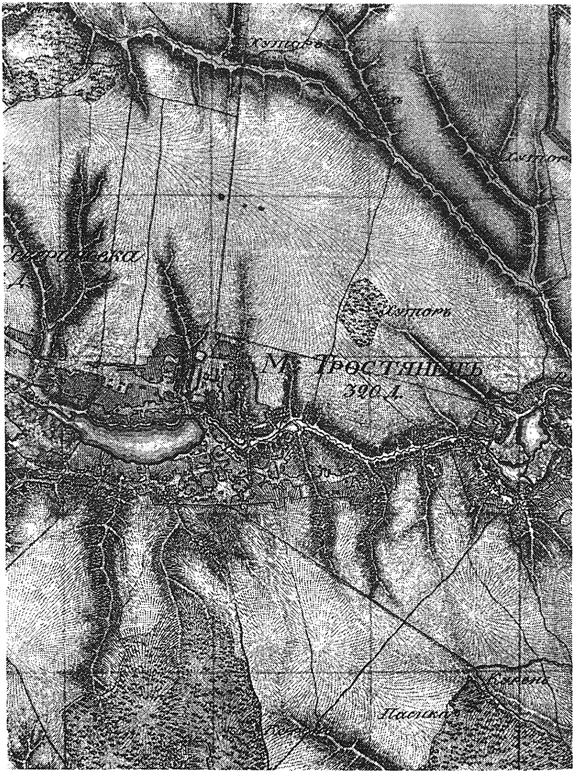
Ill. 160. Jewish cemetery. Monument at the tomb of Cheyna daughter of Shlomo, 1784 (photo 1998)
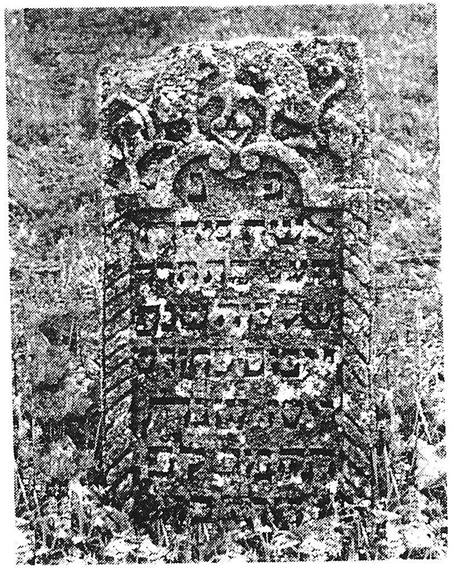
Ill. 161 Water mills, 19th century (photo 1998)
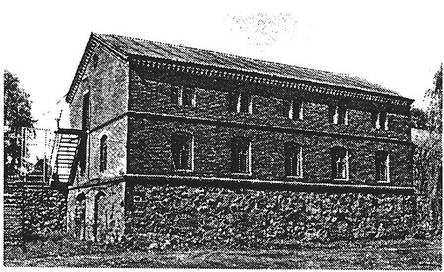
Ill. 162. Jewish cemetery. Monument at tomb of Moshe, son of Israel, 1784 (photo 1998)
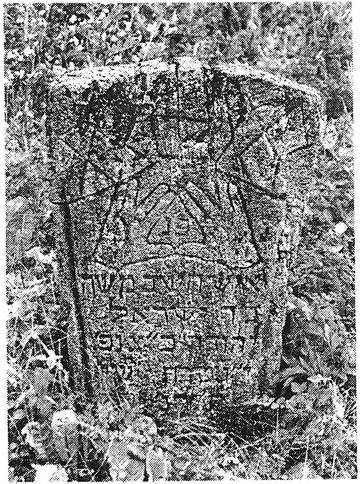
Ill. 163. Site of old Jewish cemetery (photo 1998)
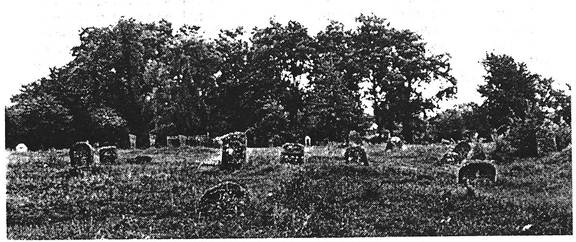
Ill. 164. Monument to the communal graves of victims of the 1919 pogrom (photo 1998)
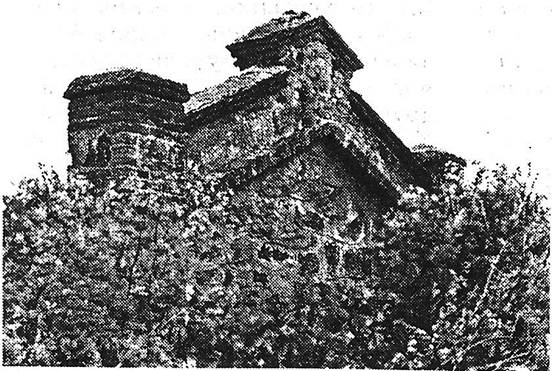
Ill. 165. The building of the synagogue (rebuilt) on Ostrovsky street (photo 1997)
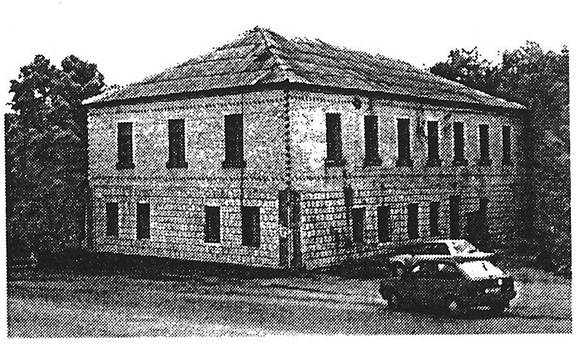
Ill. 166. Jewish cemetery. Monument from 1666? (see text) at the tomb of Moshe, son of Jacob-Samson. (photo 1998)
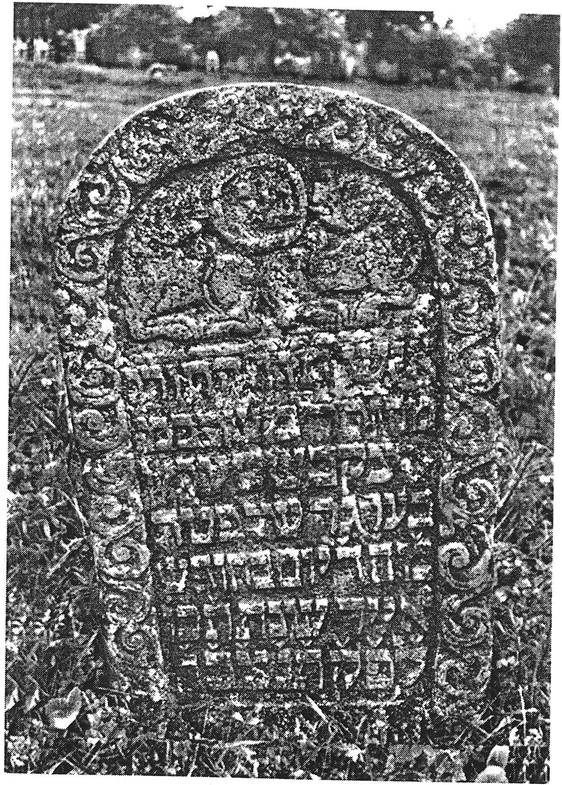
Istoria mist i sil Ukrains’koi RSR, Vinnyts”ka oblast’(IMiS-V), 598; Slownik geograficzny. Vol. 15, 8.
Arkhiv iugo-zapadnoi Rossii (AIuZR). Part 7, Vol. 2, 404; A. I. Baranovich, Ukraina nakanune osvoboditel’no? vo?ny, 1620-1647 gody. (Kyiv: Akademiia nauk Ukraïns’koï RSR, 1965), 136.
Shmuel Faibish. Tit Hayaven, 144; AiuZR, Part 7, Vol. 2, 541.
Radians’ka entsyklopedia Istorii Ukrainy. (REIU) (Kyiv, 1969-72), Vo l. 4, 194; IMiS-B, 599.
A. I. Baranovich. Opustoshenie I vosstanovlenie Pravoberezhnoi Ukrainy vo vtoroi polovine XVII i nachale XVIII vv. Istoria SSSR, 1960, Vol. 5, 155.
AIuZR, Part 5, Vol. 2, 191.
Ibid., 258.
Aryeh Kaplan. Until the Mashiach: The Life of Rabbi Nachman (Breslov Research Institute, 1985), 246.
The Central Archive of the History of Jewish People, Jerusalem (CAHJP), HM 2/8870.1.
IMiS-V, 599.
I. Galant. Do istorii remisnoii pratsi mizh evreiamy na Ukraini. Zbirnyk prats’ Evreis’koi istorychno-arkheografichnoi komisii. (Kyiv, 1929), Vol. 2, 306.
CAHJP, HM/7771.1.
IMiS-V, 599.
Ibid., 600.
Nedel’naia khronika Voskhoda (NKhV), 1989, Vol. 47, 1196.
Ibid.
Ibid.
M. Osherovich. Shtet un Shtetlakh in Ukraine, 1 (1948), 103-105.
Ves’ iugo-Zapadnyi krai, 1911, 953-954.
M. Osherovich. Shtet ..., 96.
Voskhod, 1901, Vol. 22, 19.
Ves’ iugo-Zapadnyi krai, 1911, 953.
M. Osherovich. Shtet ..., 94-97.
Eliezer David Rosental, Megillat Hatevah [The Scroll of Slaughter], Vol. 3. (Jerusalem-Tel Aviv, 1929), 105; Same author. Hatevah Beukraina, 401-407.
CAHJP, P 10, II/7/16.
S. I. Gusev-Orenburgskii. Bagrovaia kniga. Pogromy 1919-20 gg . Na Ukraine . (Kharbin: DEKOPO, 1922), 9, 19, 23-26; Elias Heifetz. The slaughter of the Jews in the Ukraine in 1919. (New York: Thomas Seltzer, 1921) 393-40; Leo Motzkin. Die Judenpogrome in Russland, 265, 268; Elias Tcherikower, The Pogroms in Ukraine in 1919. Originally in Yiddish, YIVO Institute, 1965 [8], 11; Eliezer David Rosental, Megillat Hatevah [The Scroll of Slaughter], Vol. 3. (Jerusalem-Tel Aviv, 1929), 105-109; Same author. Hatevah Beukraina, 401-407.
CAHJP, P. 10, II/7/16.
The State Archive of Vinnitsa Region (GAVO), f. P-1, op. 1, d. 1727; f. 4954, op. 1. d.13, l. 15.
DerEmes, 10/10/1923; 06/14/1923.
M . Kiper . Evreiskoe mestechko Ukrainy. (Khar’kov, 1930), 51.
M. Osherovich. Shtet ..., 94-119.
Ibid., 103.
Ibid., 97, 119.
AIuZR, Part 5, Vol. 2, 191, 258, 479, 591.
Evreiskaia Entsiklopedia. (St. Petersburg, 1908-1913), Vol. 15, 35.
L. G. Zinger. Chislennost’ i geograficheskoe razmeshchenie evreiskoe naseleniia SSSR. Evrei v SSSR. Materialy i issledovaniia. (Moscow: GU, 1929), 48.
Materials collected by Vladimir Oks and Joseph Gel’ston.
Pinkas Hakehillot: Encyclopedia of Jewish Communities, Romania, (Jerusalem:Yad Vashem, 1969), 447- 448; Materials collected by Vladimir Oks.
Materials collected by Vladimir Oks and the Ethnographic expedition of 1998.
Ibid.